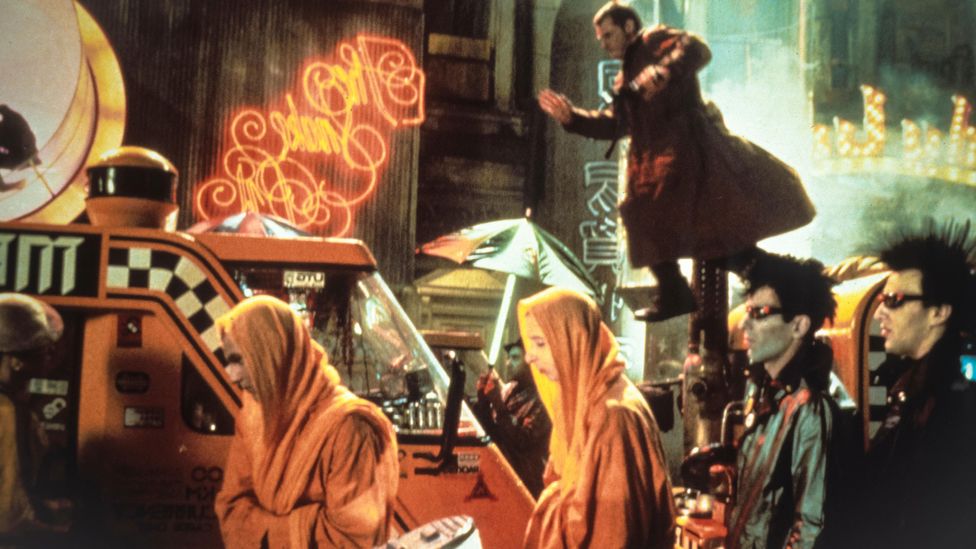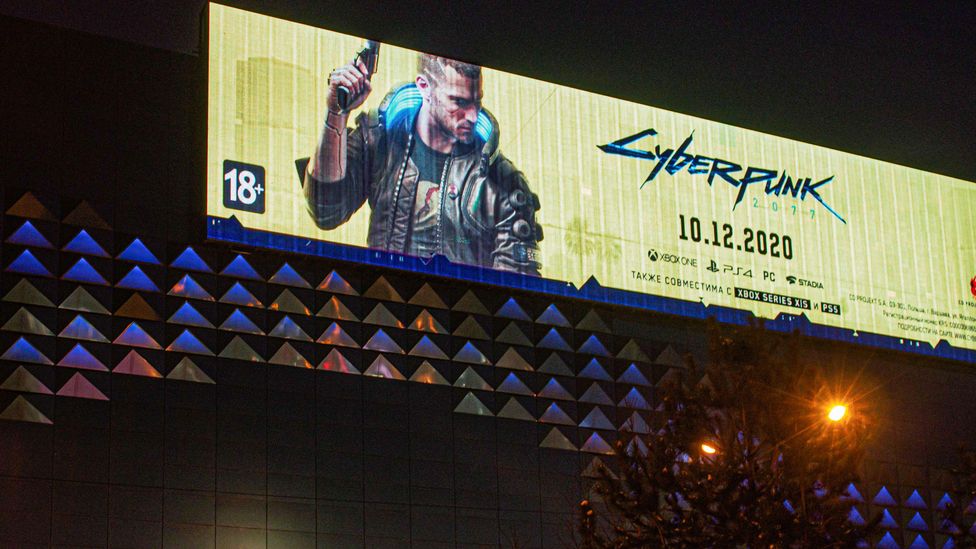Hbo Black and Blue Our Bionic Future
The Matrix and the sci-fi stories that predicted life in 2021

The dystopian movement known as cyberpunk is bigger than ever. But as the genre's greatest film franchise returns, is truth stranger than fiction, asks Sam Davies.
W
When was the peak of human civilisation? 1999, according to Agent Smith, the villainous computer program in The Matrix (1999). In the sci-fi series' iconic first film, humans have been enslaved by artificial intelligence 200 years in the future, and what they believe to be the real world is in fact a simulation. Agent Smith explains that the virtual reality – the titular Matrix – they have been tasked with upholding has been modelled on the end of the 20th Century for this reason. After that, it was all downhill for our species, apparently.
More like this:
– 10 films to watch in December
– The sci-fi director of the 21st Century
– The 1968 novel that predicted today
Looking back now, you could argue that Smith had a point. Economies were booming. 9/11 hadn't happened yet. Pandemics were a distant memory.

The Matrix Resurrections will bring back hackers Neo (Keanu Reeves) and Trinity (Carrie-Anne Moss) from the dead – but what can they offer us now? (Credit: Alamy)
It was certainly a peak of cinema: 1999 saw Hollywood films – as superficially varied as Fight Club, Office Space, Being John Malkovich and yes, The Matrix – prod at society's brittle facade, making us question our world, our reality, our very existence. The Matrix was so influential it convinced some fans that its central premise was real. In this year's documentary A Glitch in the Matrix, director Rodney Ascher interviews a whole cast of people who believe that very thing, that we are in fact in the Matrix. The Wachowski sisters' film was also a definitive work of cyberpunk, the noirish subgenre of science fiction where futuristic technologies combine with bleak, dystopian societies.
It is adored to this day, as evidenced by the mania surrounding the release of a new Matrix instalment – The Matrix Resurrections – later this month, with fans even seeming to have forgotten the two dreary sequels that came before it (both released in 2003). As per its title, the fourth film in the series promises to bring three of its most beloved characters back from the dead, with romantically-inclined hackers Neo (Keanu Reeves) and Trinity (Carrie-Anne Moss) having both seemingly died in the third film, while the bespectacled revolutionary Morpheus (Laurence Fishburne) was killed in the canonical narrative of the video-game series The Matrix Online.
All three are set to return (albeit with Morpheus in younger form, this time played by Yahya Abdul-Mateen II), along with the franchise's trademark kung-fu action sequences and an examination of "what is real". With only some cryptic trailers to go on so far, it's anyone's guess where the story goes from here, but the Matrix's central ideas (virtual reality, simulation theory) are more ingrained in our own reality now than ever before. Indeed, in a world where truth is stranger than science fiction, what can a new Matrix film – and the cyberpunk genre as a whole – offer us now?
The origins of cyberpunk
The term cyberpunk was coined in 1983 when US author Bruce Bethke wrote Cyberpunk, a short story in which a group of rebellious kids living in a technologically-advanced society skip school and rob a bank by hacking into its mainframe. Bethke explained that he wanted a term that paired technology with "socially misdirected youth, and tried out the various combinations until one just plain sounded right". Another key early cyberpunk author was Philip K Dick: though his 1968 novel Do Androids Dream of Electric Sheep prefigured the genre, when it was adapted for the big screen under the new name Blade Runner in 1982, the film became one of cyberpunk's most immortal works. Other formative cyberpunk creations include the Japanese manga series Akira (1982) and anime film of the same name (1988), William Gibson's novel Neuromancer (1984) and Mike Pondsmith's role-playing board game Cyberpunk 2020 (1988).
When it arrived in the 1980s, cyberpunk was to mainstream science fiction what punk bands were to prog rockers. Where H G Wells and Arthur C Clarke blasted off into space in search of extraterrestrial life, Gibson and co poked around in the dark, derelict world that was left behind. Though it pulsated with futuristic technology, cyberpunk portrayed a dilapidated society with vast disparities between rich and poor, rampant crime and drug use, corrupt governments whose power was dwarfed by that of megacorporations and an atmosphere thick with pollution, following untold climate disasters. The best definition of the genre is the simplest: high tech, low life.
Another recurring motif, one that lends cyberpunk its punk spirit, is that of state-of-the-art technologies being co-opted and repurposed by subcultural rebels, like Neo and co using simulation tech in The Matrix. "I think one of the key elements is the notion that 'the street finds its own uses for things'," as cyberpunk author Neal Stephenson puts it, quoting from his peer William Gibson's 1982 short story Burning Chrome. His point is that cyberpunk authors are interested not only in predicting future technologies, but also in guessing their often renegade uses. "When electricity became widely available, and lots of things got electrified, the engineers who were envisioning the future were naturally thinking in terms of electric washing machines, or toasters, maybe even… cars. But I don't think any of them thought of the electric guitar," Stephenson tells BBC Culture. "And even if they had, they probably wouldn't have guessed that it would catalyse an enormously powerful movement in popular music."

Blade Runner became one of cyberpunk's most famous early works, embodying its dystopian spirit (Credit: Alamy)
"If you had predicted all that in a novel in say 1920... people would have found it quite... bizarre," he continues. "But it's exactly what happened. So electric guitars are, in my way of thinking, classically cyberpunk phenomena. The challenge is to try to imagine something as bizarre and hard to predict as that, and get people to believe it could really happen." Stephenson knows more about cyberpunk than most ("I've heard of it," he says, with typical dryness): his 1992 novel Snow Crash, set partly in a metaverse (of which more later), is another of the genre's foundational works.
He speaks over video call from his home in Seattle, his connection hampered by an incoming storm that's about to devastate much of the US upper west coast. This and his tendency to take long, thoughtful pauses in the middle of sentences give his voice a slightly robotic edge.
It may now be decades old, but cyberpunk is booming. /r/cyberpunk, a Subreddit dedicated to the genre, has over 620,000 subscribers and counting. Inspired by Pondsmith's tabletop role-playing game, Cyberpunk 2077 – where players roam a lawless city 50 years in the future – is among the most popular video games of recent years, selling more than 10 million copies within a month of its launch in December 2020. One of its characters (Johnny Silverhand, played by The Matrix's Keanu Reeves) even inspired the non-profit organisation Limbitless to 3D-print a version of the character's bionic arm for real-world amputees.
Meanwhile in recent years cyberpunk TV series like Blade Runner: Black Lotus, Cowboy Bebop, Altered Carbon, Omniscient, 3% and Ad Vitam have all hit streaming services. Even in music, cyberpunk's influence is clear: videos for pop hits like Lil Nas X's Panini and Doja Cat's Need to Know place their stars in murky alleyways and seedy nightclubs, as flying cars and holograms drift overhead. The future is here – and it looks just like the 1980s.
What is fuelling our cyberpunk obsession? Perhaps our society is now so similar to those portrayed in the genre that we've become transfixed gazing at our own reflection, making works of cyberpunk feel less like science fiction and more like a crystal ball. Curiously, we're now living in exactly the era that many of cyberpunk's original creators were looking towards. Blade Runner and Akira are both set in 2019. Cyberpunk 2020 is set in 2020. Johnny Mnemonic, the 1981 William Gibson short story and later 1995 film (again starring the face of cyberpunk Keanu Reeves), is set in 2021. Our skies remain largely free of flying cars, and cyborgs have yet to integrate into society. But in many other ways cyberpunk, its ideas and its inventions are more real now than ever.
Long before they entered mainstream public consciousness, ideas like cyberspace, augmented reality, megacorps, transhumanism and – 2021 buzz-concept – the metaverse were fictional inventions in cyberpunk texts.
The concepts that took over the world
Gibson coined the word "cyberspace" in Burning Chrome, before popularising the term with 1984 novel Neuromancer, a cult hit in which hacker Henry Dorsett Case takes on a shady mission in a virtual reality dataspace called the matrix. "A consensual hallucination experienced daily by billions of legitimate operators," is how Gibson describes it in an often-quoted passage that many see as having prefaced the World Wide Web. Gibson also popularised the term "megacorp", referring to a conglomerate with monopolistic power over numerous markets, so vast that its influence over society eclipses that of any government.
Some would suggest these megacorps are now very much a reality, run by moguls who have more power than presidents. The most powerful man in Snow Crash is L Bob Rife, a media tycoon who proclaims to "deal in information", controlling the world's television and the network through which the metaverse runs. He's also accused of spying on his employees and using their private information against them. Stephenson says the real world is yet to produce anyone quite as omnipotent as Rife, "but somehow we have reached a state where we, as a society, now look to billionaires as... problem solvers". Stephenson's own CV includes working as a "futurist" at Blue Origin, an aerospace company founded by Jeff Bezos, with whom Stephenson maintains sporadic contact.

The success of videogame Cyberpunk 2077 – which sold over 10 million copies within a month of its launch – is proof that cyberpunk is booming (Credit: Alamy)
Virtual-reality headsets, as seen in The Matrix, Neuromancer, Johnny Mnemonic and many other works of cyberpunk, have become especially popular during the pandemic, allowing people to attend gigs, festivals, exercise classes, Black Lives Matter protests and even surgical training without leaving their homes. Augmented reality, traceable as far back as Philip K Dick's 1956 short story The Minority Report, and running through cyberpunk works from Neuromancer to Paul Verhoeven's 1987 movie RoboCop, is one of the fastest growing technologies in the world, with the approaching mainstream arrival of AR glasses and AR contact lenses.
The principle of deepfakes – digitally altering a person's identity to deceive a viewer – can be seen in The Running Man, the 1987 cyberpunk film (set in 2017) where a TV corporation uses "digital matte tracking" to frame Arnold Schwarzenegger's rogue army man for crimes he didn't commit. Cryptocurrency, meanwhile, was prefaced in Neal Stephenson's 1999 novel Cryptonomicon (and Stephenson has even been wryly suggested as the real person behind Satoshi Nakamoto, the pseudonymous inventor of Bitcoin).
But what if, as speculative author Jack Womack writes in the afterword of Neuromancer's 2000 US reprint, "the act of writing it down, in fact, brought it about?" Many have credited Gibson's work as not only predicting cyberspace, but also influencing its development, "creating an iconography for the internet age," as one journalist put it.
John Hanke, technologist and former director of Google's Geo production division, has cited Earth, a fictional software in Snow Crash that allows characters to view the planet through a precise virtual replica, as the inspiration for Earth Viewer, a 2001 invention that eventually became Google Earth. Google cofounder Sergey Brin is another fan of Snow Crash. In a recent episode of Wired's podcast Geek's Guide to the Galaxy, host David Barr Kirtley says he began making a list of Silicon Valley inventors and entrepreneurs who have cited Snow Crash as an influence, but "just kind of stopped at a certain point, because it was basically everyone".
At the core of the novel is the metaverse, a fully immersive, 3D, virtual – which is to say pretend, unreal, not actually there – reality in which humans can coexist and interact, just like the Matrix in The Matrix. The metaverse has started to feel very real in recent months though, after Facebook announced plans to build their own. Mark Zuckerberg outlined his vision of "an embodied internet where you're in the experience, not just looking at it", while also revealing that he'd even renamed Facebook's parent company Meta. "You're gonna be able to do almost anything you can imagine: get together with friends and family, work, learn, play, shop, create," added Zuckerberg, declaring that the metaverse would be Facebook's – sorry, Meta's – top priority henceforth. Facebook's metaverse announcement has been followed by similar statements of intent from Disney and Microsoft, while more niche metaverses like virtual-reality platform Decentraland are already popular among dedicated online communities.
"I have nothing to do with anything that FB is up to involving the metaverse," Stephenson tweeted in October. He may not mean to. But according to Facebook data scientist Dean Eckles, Zuckerberg once made Snow Crash compulsory reading for all his product managers at the company. Like the one in Stephenson's novel, Zuckerberg's metaverse will be populated by avatars (a term which Snow Crash also brought into Western consciousness) representing real people, who can build virtual homes, buy artificial items, converse with others and – crucially, according to Zuckerberg – make you feel like you're really there. Also as in Snow Crash, Meta's virtual world will be accessible using specially designed goggles, as well as on existing platforms like phones and computers.
Are cyberpunk fans missing the point?
For all the tech giants' embrace of the metaverse, many have pointed out that Snow Crash depicts a dystopia, not a blueprint for a better world. "The book is kind of dystopian and cautionary in a number of ways," agrees Stephenson. "So trying to implement technology that is described in such a book might not be sending the message you think you're sending." But he's hesitant to condemn the metaverse as a dystopian idea in itself. "The metaverse per se, as described in the book, really doesn't go one way or the other. It's a fairly neutral communications medium that's used by a lot of people in a range of ways, some of which are clearly bad people doing bad things, for lack of a better term, but others are just ordinary people trying to hold conversations with each other, the way we do now over Zoom. Some people might use Zoom to plan a bank robbery, but others might use it for charitable purposes or creative purposes."

Virtual reality has become particularly popular during the pandemic, allowing people to have experiences without leaving their homes (Credit: Alamy)
However, there is a concern that those who are appropriating ideas or aesthetics from cyberpunk may be missing the point. William Gibson recently admitted that he has deliberately self-censored his work, deciding not to include certain ideas in his books, as he was afraid that someone might try to copy them.
"Cyberpunk is a warning, not an aspiration," Mike Pondsmith said in the wake of Cyberpunk 2077's popularity, warning his audience against fetishising cyberpunk's dystopian vision in real life. The quote appears in issue 6 of CYBR, a magazine launched in 2018 dedicated to futuristic tech culture, combining real interviews with ads for fictional products like DNA-sequenced smoothies and off-world travel. If you go to CYBR's Instagram page, choose the right filter and aim your camera at Issue 6's cover, its star – a pink-haired cyborg named Lizzy Wizzy, based on the Canadian musician Grimes – will levitate above the page in hologram form. Inside, Grimes is quoted as saying she'd like to upgrade her hands "to avoid arthritis and enable enhanced combat". CYBR's editor and founder James Joseph says he has been "very into cyberpunk as a genre my entire life. I do feel like the cyberpunk genre is getting so big that it's being seen as an aesthetic, and the warning is being forgotten."
But what, you might ask, has cyberpunk got left to warn us about? The climate crisis is upon us, with skies in Beijing so polluted they're hard to distinguish from Blade Runner. Corporate power has arguably eclipsed that of any government, with some provocative commentators even calling for Facebook and Amazon to be given seats at the United Nations. Meanwhile the world continues to struggle with a deadly virus – something you'll find in cyberpunk works like Snow Crash and Johnny Mnemonic (though in The Matrix, Agent Smith says humans themselves are "a virus… a disease, a cancer of this planet. You are a plague, and we are the cure.")
"It's kind of hard…" Stephenson says, then remembers the incoming storm. "I'm just checking the forecast… It's hard not to see some strong dystopian aspects to what is... going on [in the world at the moment]." He notes that what makes most works of fiction, including cyberpunk ones, distinguishable from reality is the fact that they typically offer some kind of resolution. "I guess the big difference is, in a book you have a hero who saves the day. It's kind of expected. It's part of the form. And there's an implication that once the hero has saved the day everything is different now and things are going to get better… This rarely happens in the real world." Which makes our reality sound even more bleak than a cyberpunk dystopia.
Where does the genre go from here?
Yet even though most cyberpunk stories culminate in victories for their heroes, not many end with a happy planet. "Nobody has yet imagined a way out of the typical cyberpunk dystopia ... which is surely a symptom of a creative block," Paul Walker-Emig noted in a 2018 article for the Guardian critiquing the genre. For him, he wrote, modern works of the genre like Cyberpunk 2077 and Altered Carbon had done little other than employ "cool cyberpunk symbols" without ever challenging the status quo. He suggested instead that cyberpunk should update to offer a utopian image of the future, guiding us towards a better life.
Stephenson's new novel Termination Shock, published in October, certainly toys with a solution to one of the world's most pressing concerns. In an unspecified year in the near future, when climate change has wrought havoc on the planet, one character purports to cool down the planet by firing sulphur into the air and reflecting sunlight back into space. But the results are less than promising.

Earlier this year, Facebook's Mark Zuckerberg outlined his vision of a "metaverse" – a concept invented in cyberpunk novel Snow Crash (Credit: Alamy)
A flick through the cyberpunk literature from the past decade offers a similar sense of doom. Authors imagine worlds where people escape the hell of reality into a virtual realm (Ready Player One), entire towns are ravaged by electronic trash (Waste Tide), global democracy is powered by monopolistic search-engine corporations (Infomocracy), humans are addicted to cybernetic implants (The Body Scout) and developing countries are exploited for their sustainable energy (Noor). Familiar cyberpunk tropes – holograms, megacorps, rebellious subcultures – recur. Optimism remains largely absent.
However bleak it may be, cyberpunk's popularity looks set to continue. The latest issue of CYBR, which imagines the world in 2070, gives readers the choice of two covers, a dystopian one, showing a murky, polluted world, and a sunny, colourful, utopian one. "It's our climate-change issue," says the editor. "The choice is ours, right? In 50 years time, what will the world look like? So the idea of doing two covers is you can choose what future you want." Joseph says the dystopian cover is set in a cyberpunk future, while the utopian one is solarpunk – a recently coined term that imagines a world where technology has helped humans overcome issues like climate change. "Ironically, the dystopian cover is selling at twice the rate as the utopian cover. I think people find it cooler."
The first Matrix film included a biting critique of our fascination with dystopia. Agent Smith tells us the original simulation that humans were placed in was a paradise, designed to keep everyone happy. But "it was a disaster," he says, explaining that the humans couldn't accept the program and kept trying to wake up from it. He goes on: "I believe that as a species human beings define their reality through misery and suffering."
Considering their influence, it's possible cyberpunk works like The Matrix not only predicted a dystopian future, but also enticed us towards one. If Resurrections is to succeed, to give us anything we haven't already had from the past 40 years of cyberpunk, perhaps it can suggest a new direction for humanity, an image of a world where humans work alongside machines to escape our impending doom. Or maybe it will simply offer us an escape from reality. As Morpheus says in the original film: "Fate, it seems, is not without a sense of irony."
The Matrix Resurrections is released on 22 December in cinemas and on HBO Max in the US, and in cinemas in the UK
Love film and TV? Join BBC Culture Film and TV Club on Facebook, a community for cinephiles all over the world.
If you would like to comment on this story or anything else you have seen on BBC Culture, head over to our Facebook page or message us on Twitter .
And if you liked this story, sign up for the weekly bbc.com features newsletter , called The Essential List. A handpicked selection of stories from BBC Future, Culture, Worklife and Travel, delivered to your inbox every Friday.
Source: https://www.bbc.com/culture/article/20211207-the-matrix-and-the-sci-fi-stories-that-became-a-reality